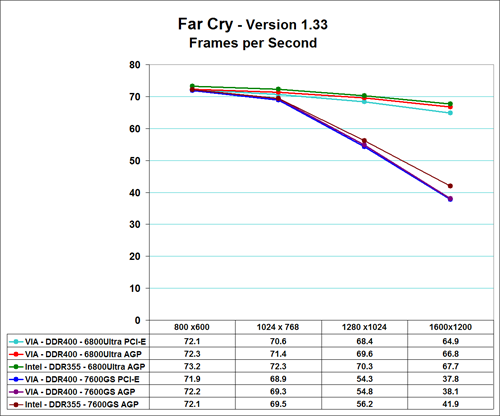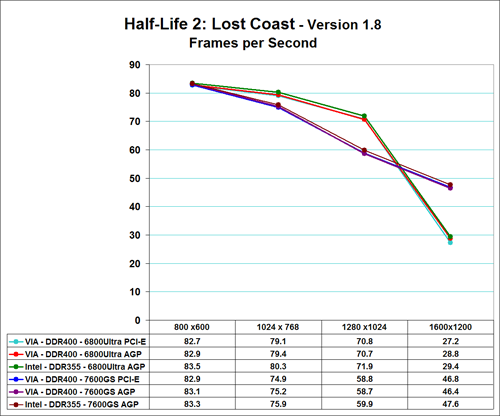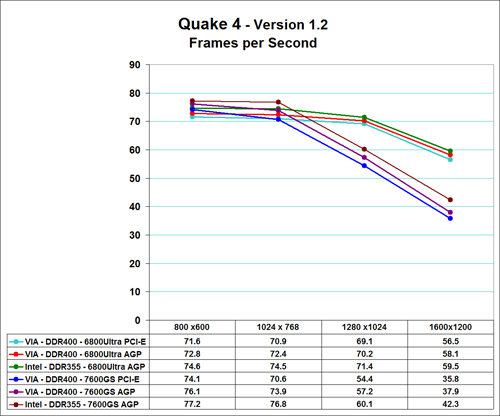ASRock Core 2 Duo: AGP/PCI Express Graphics Performance, Part Tres
by Gary Key on August 15, 2006 6:30 AM EST- Posted in
- Motherboards
Graphics Performance Comparison
While our previous articles concentrated on memory performance, today's article solely consists of gaming benchmarks and the synthetic 3DMark tests from Futuremark. The 3DMark series of benchmarks developed and provided by FutureMark are among the most widely used tools for benchmark reporting and comparisons. Although the benchmarks are very useful for providing consistent comparisons across a broad array of GPU and CPU configurations they are not a substitute for actual application and gaming benchmarks. In this sense we consider the 3DMark benchmarks to be purely synthetic in nature.
The gap between PCI-E and AGP solutions is less than 2% with both video card choices. Our first tests show AGP performing slightly better than PCI-E on the VIA platform with the Intel platform performing better overall. The 6800 Ultra series outperforms the 7600GS up to 38% in 3DMark05 and 26% in 3DMark06. Let's see if these differences carry over into our game benchmarks.
We utilized Far Cry, Half Life 2 and Quake 4 in our memory test articles because they are sensitive to memory changes and potentially bus throughput issues in our comparison. We added Prey and Serious Sam 2 to our benchmark mix because they are typically very GPU dependent and scale well. We originally tested at both 1024x768 and 1280x1024 resolutions at High Quality settings without anti-aliasing or antistrophic filtering enabled. We have also added 800x600 and 1600x1200 resolutions with the same settings.
Our three memory sensitive games show a consistent pattern with the AGP capability of the ASRock 775Dual-VSTA performing up to 5% higher than the PCI-E version in our testing. Overall, the AGP slot performance is better than the PCI Express slot even in 800x600 testing where the X4 operation handicap should not make a difference. The Intel 865 chipset offers better AGP performance especially as the resolutions start to scale upward. Looking at the gaming results from our previous article, the X16 PCI-E solutions typically offer equal or better performance than the AGP offerings. Whether it's the extra bandwidth or simply a less-than-perfect PCI-E implementation on the 775Dual-VSTA we can't say without further testing. However, the bottom line is that AGP performance is better than PCI-E performance on this particular motherboard.
The 6800 Ultra is still a very competitive card when compared to the 7600GS in these particular benchmarks, although it stumbles at 1600x1200 in Half Life 2- Lost Coast. The ATI X850XT-PE would score in a similar fashion if not better than the 6800 Ultra, though of course it lacks SM3.0 support which can be useful in more recent titles. Those owners with a graphics card in this class can still get by with most of today's games. We will have Oblivion results in our final article although we highly suggest going with a different solution to play this game at decent settings
While our previous articles concentrated on memory performance, today's article solely consists of gaming benchmarks and the synthetic 3DMark tests from Futuremark. The 3DMark series of benchmarks developed and provided by FutureMark are among the most widely used tools for benchmark reporting and comparisons. Although the benchmarks are very useful for providing consistent comparisons across a broad array of GPU and CPU configurations they are not a substitute for actual application and gaming benchmarks. In this sense we consider the 3DMark benchmarks to be purely synthetic in nature.
 |
| Click to enlarge |
The gap between PCI-E and AGP solutions is less than 2% with both video card choices. Our first tests show AGP performing slightly better than PCI-E on the VIA platform with the Intel platform performing better overall. The 6800 Ultra series outperforms the 7600GS up to 38% in 3DMark05 and 26% in 3DMark06. Let's see if these differences carry over into our game benchmarks.
We utilized Far Cry, Half Life 2 and Quake 4 in our memory test articles because they are sensitive to memory changes and potentially bus throughput issues in our comparison. We added Prey and Serious Sam 2 to our benchmark mix because they are typically very GPU dependent and scale well. We originally tested at both 1024x768 and 1280x1024 resolutions at High Quality settings without anti-aliasing or antistrophic filtering enabled. We have also added 800x600 and 1600x1200 resolutions with the same settings.
 |
 |
 |
| Click to enlarge |
Our three memory sensitive games show a consistent pattern with the AGP capability of the ASRock 775Dual-VSTA performing up to 5% higher than the PCI-E version in our testing. Overall, the AGP slot performance is better than the PCI Express slot even in 800x600 testing where the X4 operation handicap should not make a difference. The Intel 865 chipset offers better AGP performance especially as the resolutions start to scale upward. Looking at the gaming results from our previous article, the X16 PCI-E solutions typically offer equal or better performance than the AGP offerings. Whether it's the extra bandwidth or simply a less-than-perfect PCI-E implementation on the 775Dual-VSTA we can't say without further testing. However, the bottom line is that AGP performance is better than PCI-E performance on this particular motherboard.
The 6800 Ultra is still a very competitive card when compared to the 7600GS in these particular benchmarks, although it stumbles at 1600x1200 in Half Life 2- Lost Coast. The ATI X850XT-PE would score in a similar fashion if not better than the 6800 Ultra, though of course it lacks SM3.0 support which can be useful in more recent titles. Those owners with a graphics card in this class can still get by with most of today's games. We will have Oblivion results in our final article although we highly suggest going with a different solution to play this game at decent settings










43 Comments
View All Comments
hibachirat - Saturday, August 19, 2006 - link
I agree that the AGP vs. PCIE would better be compared on another board, but I think Gary's point with these articles was more that those of us with decent AGP cards don't need to dash out and buy a $200 MB, $300 of DDR2 RAM, and a $300 PCIE GPU, just to upgrade to a Core 2 CPU. I'm sure it will run great for more than a year, but by that time it will probably be working as test PC somewhere in the office after I splurge for those other new parts.Yeah, some of those Newegg "junk" people make me yell. Just saw one yesterday where somebody ordered a case and then returned it because the power supply wattage rating was too low for them. Of course the power supply rating was stated clearly in the specs on the same page...doh!
joex444 - Wednesday, August 16, 2006 - link
did you really just write a review and do benchmarks to show that AGP is faster than PCI-E x4? I thought this was a given. Next, why don't you see if x16 has more performance than x4, use a real slot and just tape the pins to cripple the card. Gosh, I'd love to hear how that turns out. Next up: Do you really need L1 cache?Paradox999 - Wednesday, August 16, 2006 - link
I have to congradulate AT for this great series.Chalk me up as another person who is looking at either the ASRock 775i65G or ASRock 775Dual-VSTA for a quick upgrade with one of the lower cost Conroes and recycled 2gigs Mushkin DDR500 and AGP Ati x850XTPE.
What I really want to know is does the ASRock 775i65G have any cpu voltage adjustment at all, or is it stable with mild overclocking on the Conroe? With it's superior performance I prefer the ASRock 775i65G. I'd leave the DDR2/PCI-E to a later bigger upgrade that would at that time include a better motherboard.
Cheers!
Gary Key - Thursday, August 17, 2006 - link
It does not have any voltage options. The FSB is limited to 300 which is no issue for a E6300/6400 to hit without a volt increase. The board is extremely stable at 300FSB.
Paradox999 - Thursday, August 17, 2006 - link
Gary,thanks. If i understand you correctly, I *shoud* get a 300fsb with both low end Conroes but with the higher multiplyer of the E6400 that might be the sweet spot for this 'budget' system.
Thanks again for the reviews!!!!!
teraus - Wednesday, August 16, 2006 - link
i am about to buy this board along with a e6600 conroe with my gainward 7800gs+ and ddr pc3200 memory. this is a fill in until next year. found the article very interesting.there are people who always buy the latest thing and some of us look for performance on a budget and buy later and smarteri dont intend to use a pcie card with this board
zemane - Tuesday, August 15, 2006 - link
I would like to know the performance of a system with my video card, ATI A-I-W X800 XT AGP on this motherboard using a Core 2 Duo E6300 or E6600 CPU and 2GB memory, since I am planning to upgrade to something like that soon. And how it would later perform if I upgrade that with a mid-range PCI-E card. Thanks!lemonadesoda - Tuesday, August 15, 2006 - link
I would like to have seen the comparison of this mainboard PCI-4x against a PCI-8x or 16x with similar CPU so we can see how much of a bottleneck (or performance loss) there is with this system. Plase consider a PART 4.kmmatney - Tuesday, August 15, 2006 - link
Like the lack of Socket 939 Semprons, I think the lack of a low cost Conroe (Core Solo>) is a major bummer. I guess you can always get a Pentium D for cheap, but then your back to a hot, power hungry processor. When are "Celeron" Core processors die out?mendocinosummit - Tuesday, August 15, 2006 - link
I am getting tired of this motherboard. Anandtech has not done a real interesting review that I have actually read for almost two weeks. When are there going to be some different reviews.